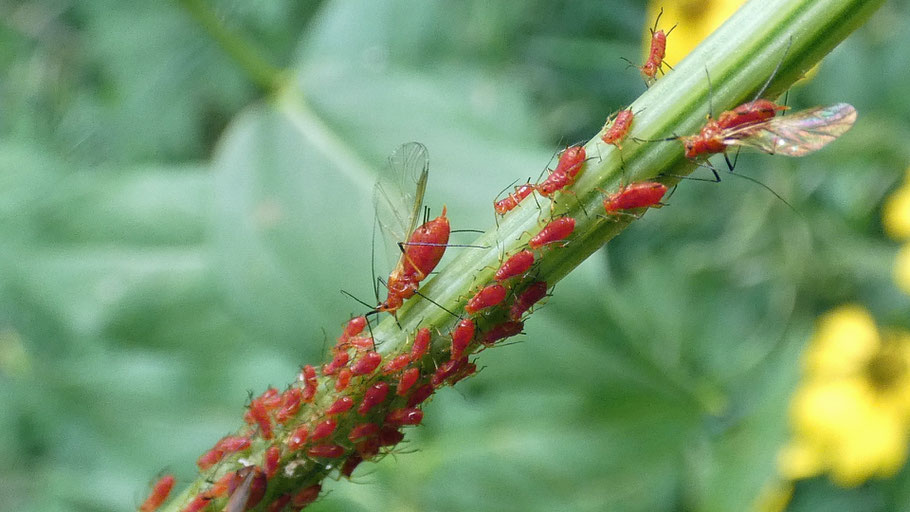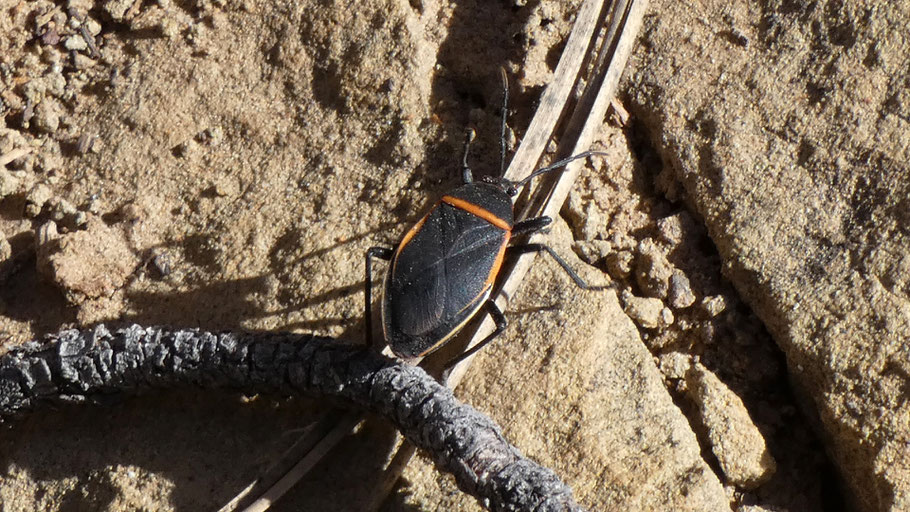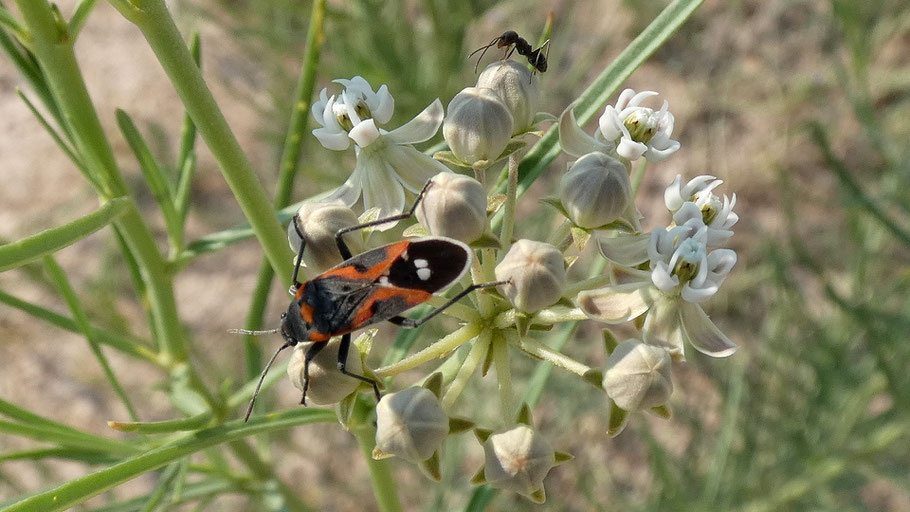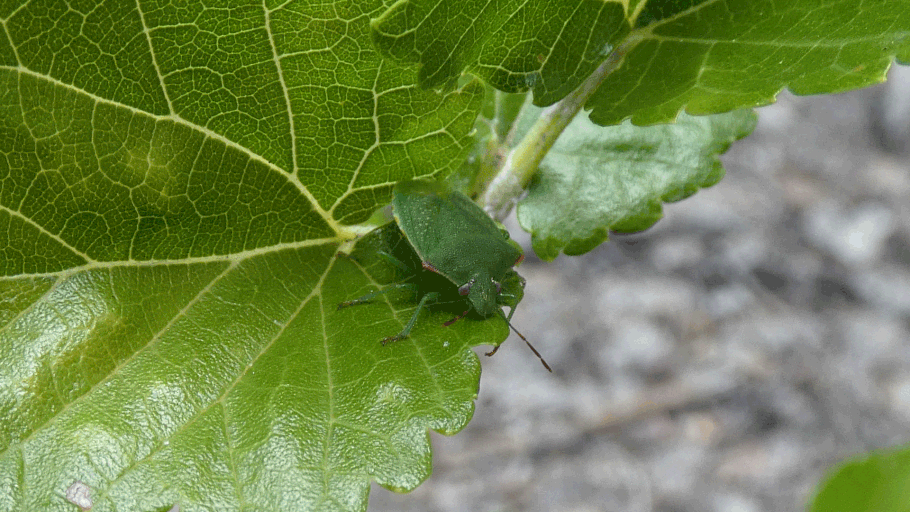A Few New Mexico Insects: True Bugs
(Hemiptera)

A defining characteristic of true bugs is their stylets, which are mouth parts like pointed tubes. True bugs use them to penetrate food sources. They inject digestive fluid and suck out the resulting yummy broth. Most species are vegans but some—notably, assassin bugs—use their stylets to pierce fellow insects and consume the innards. Sounds gruesome to me, but in doing so they rid the world of countless insects considered harmful by humans. When a stylet isn't in use, the bug keeps it folded back under its head, not unlike the blade on a pocket knife.
The following photos are organized alphabetically, by family or superfamily, genus, and species. If you see an error, please let me know via the contact tab at the top of the page.
Alydidae (Broad-headed Bugs): Lupine Bug (Megalotomus quinquespinosus)
Not the best photos, but I threw them online for two reasons. First, what a great big Latin name for such a little bug! Second, because one photo shows the stylet folded back under the head. Lupine bugs are vegans, feeding on plants in the pea family and on occasion on sumacs.
Aphididae: Oleander Aphid (Aphis nerii)
All three photos show Oleander Aphids on Horsetail Milkweed. You can see more of that wildflower on a separate page. Oleander Aphid females produce new young female aphids, no males required. In other words, all of the aphids shown in these pictures are females.
Aphididae: Mealy Plum Aphid, Hyalopterus pruni
The following summary is based on this web page. Hyalopterus pruni spends its winters on species of Prunus (including plum and apricot trees) and its summer on reeds, preferably the Common Reed. The aphids are usually green but can also be a dull red. In the spring, the eggs hatch on the host trees. In the summer some of the aphids grow wings and fly off to find reeds. Late in the summer, some aphids on reeds grow wings and seek out trees where they can lay eggs. The new eggs hatch the following spring. As part of this cycle, the aphids molt and leave behind their former exoskeletons. Those are the small white things you can see in my photos.
While this aphid is not usually considered to be a species attended by ants, the web page I mentions offers photographs of such behavior. As do my photographs.
Aphididae: Uroleucon

Berytidae: Stilt Bug (Jalysus?)
Stilt bugs have long, slender legs, along with long antennae with slightly club-shaped endings. I found these ones hanging out on Linda Tarde flower spikes. Stilt bugs in the genus Jalysus feed on Evening Primrose Family members, so the examples shown here are probably of that genus.
Cercopoidea (superfamily): Froghoppers
The adult members of the Cercopoidea are known as froghoppers, thanks to their impressive leaps. The plant-sucking nymphs, or spittlebugs, cloak themselves in a protective secreted foam that resembles spittle.
Cicadellidae (Typical Leafhoppers): Cuerna striata
I've seen this species referred to as striped or striated leafhoppers, but those common names may not be widely accepted.
Cicadidae: Cicadas
There are multiple species of cicada in New Mexico, in more than one genus. Several photos show what people usually find: the empty exoskeleton of a cicada nymph. The adult emerges from a slit in the back. In one image the branch has been bent back to provide a view of the slit. The image with the nymph exoskeleton upside down shows it in the position in which I found it. The November 2023 image shows mud still clinging to the exoskeleton. Such discarded exoskeletons are known as exuviae (usually plural).
Coccoidea (superfamily), Dactylopiidae: Cochineal Bug (Dactylopius)
If you notice small white puffy areas on the surfaces of prickly pear pads, you're looking at female cochineal bugs and their nymphs. To be more exact, you're looking at the protective covering those bugs create. In pre-contact southern Mexico, cochineal bugs were raised on groves of prickly pears and harvested to produce a vivid red dye. If you pinch one of the fuzzy patches between your thumb and forefinger, you'll see the dye source (carminic acid) for yourself. Today, cochineal bugs are a source of natural red food coloring, so you may have ingested some cochineal bug juice at some point.
Coccoidea (superfamily), Coccidae? Scale insect (cf. Saissetia)
There are about 8,000 described species in the superfamily Coccoidea (or infraorder Coccomorpha, if you prefer). I have no idea which species this may be; my limited ID is courtesy of an entomologist. As a lay person, my only accomplishment was to notice numerous black spots on (but not in) barberry leaves, and that the spots were all the same size, the same shape (oval), and shiny. By the way, "cf." is science-speak for "looks a lot like."
Coreidae (Leaf-Footed Bugs): Leptoglossus
My wife saw this female leaf-footed bug laying a chain of eggs on our front step railing, and came to ask me about it. I grabbed my camera, of course. The photos show a female laying a chain of eggs. My thanks to Ken Wolgemuth (via BugGuide) for the ID to the genus level.
Gerridae: Water Striders
There are more than 1,700 species of water striders on our planet. Most people credit their ability to walk on water to surface tension alone, but it helps to have legs with hydrophobic surfaces.
Largidae: Bordered Plant Bug (Largus)

Largidae: Bordered Plant Bug (Stenomacra marginella)
Lygaeidae: Small Milkweed Bug (Lygaeus kalmii)

Pentatomidae: Green Stink Bug? (Chinavia hilaris?)

While this individual resembles a green stink bug, Chinavia hilaris, the coloration doesn't seem quite right to me.
Pentatomidae: Conchuela Bug (Chlorochroa ligata)
Conchuela bugs are common in New Mexico. At times it's an agricultural pest but given where I found it (on a Siberian elm, in the Bosque), it's not a bother to anyone.
Pentatomidae: Say's Stink Bug (Chlorochroa sayi)
Reduviidae: Bee Assassin (Apiomerus)

The common name for Apiomerus, bee assassin, refers to their habit of waiting in flowers for an insect to come by.
Reduviidae: North American Wheel Bug (Arilus cristatus)
The back of this assassin bug has a crest shaped like part of a cogwheel. The stylet is clearly visible.
Reduviidae: Pale Green Assassin Bug (Zelus luridus)
Reduviidae: Leaf Hopper Assassin Bug (Zelus renardii)
In these images, the stylet doesn't jump out at you, but it's there if you look carefully. I found the adult working over a patch of Emory's Baccharis. The nymph was on a Russian Olive.
Rhopalidae: Scentless Plant Bugs (Harmostes)
Rhopalidae: Boxelder Bug (Boisea trivittata)
































































































